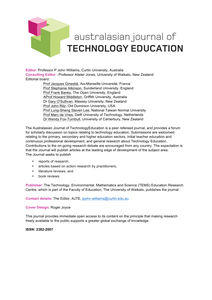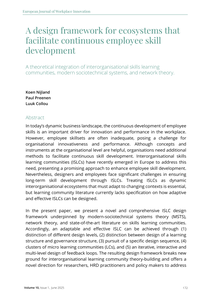This paper presents a mixed methods study in which 77 students and 3 teachers took part, that investigated the practice of Learning by Design (LBD). The study is part of a series of studies, funded by the Netherlands Organisation for Scientific Research (NWO), that aims to improve student learning, teaching skills and teacher training. LBD uses the context of design challenges to learn, among other things, science. Previous research showed that this approach to subject integration is quite successful but provides little profit regarding scientific concept learning. Perhaps, when the process of concept learning is better understood, LBD is a suitable method for integration. Through pre- and post-exams we measured, like others, a medium gain in the mastery of scientific concepts. Qualitative data revealed important focus-related issues that impede concept learning. As a result, mainly implicit learning of loose facts and incomplete concepts occurs. More transparency of the learning situation and a stronger focus on underlying concepts should make concept learning more explicit and coherent.
DOCUMENT

Learning by Design (LBD) is a project-based inquiry approach for interdisciplinary teaching that uses design contexts to learn skills and conceptual knowledge. Research around the year 2000 showed that LBD students achieved high skill performances but disappointing conceptual learning gains. A series of exploratory studies, previous to the study in this paper, indicated how to enhance concept learning. Small-scale tested modifications, based on explicit teaching and scaffolding, were promising and revealed improved conceptual learning gains. The pretest-posttest design study discussed in this paper confirms this improvement quantitatively by comparing the conceptual learning gains for students exposed to the modified approach (n = 110) and traditional approach (n = 77). Further modifications, which resulted in a remodified approach tested with 127 students, show a further improvement through reduced fragmentation of the task and addressed science. Overall, the remodified approach (FITS model: Focus - Investigation - Technological design - Synergy) enriches technology education by stimulating an empirical and conceptual way of creating design solutions.
DOCUMENT

This paper presents a mixed methods study in which 21 first-year student teachers took part that investigated learning outcomes of a modified learning by design task. The study is part of a series of studies that aims to improve student learning, teaching skills and teacher training. Design-based science challenges are reasonably successful project-based approaches for breaking down the boundaries between traditional school subjects. Previous learning outcomes of the extensively studied Learning by Design (LBD) approach demonstrated a strong positive effect on students’ skills. However, compared to traditional classroom settings, LBD provided little or no profit on (scientific) concept learning. For this, according to two preliminary studies, a lack of explicit teaching and scaffolding strategies, both strongly teacher-dependent, bears a share of responsibility. The results of this third study indicate that more emphasis on these strategies indeed strengthens concept learning without reducing positive effects on skill performance.
DOCUMENT

Academic design research often fails to contribute to design practice. This dissertation explores how design research collaborations can provide knowledge that design professionals will use in practice. The research shows that design professionals are not addressed as an important audience between the many audiences of collaborative research projects. The research provides insight in the learning process by design professionals in design research collaborations and it identifies opportunities for even more learning. It shows that design professionals can learn about more than designing, but also about application domains or project organization.
DOCUMENT

Deze casestudie geeft inzicht in verschillende soorten kennis die kenmerkend zijn voor applied design research. Er wordt onderscheid gemaakt tussen kennis over de huidige situatie, over wenselijke alternatieven en over effectieve oplossingen om daar te komen. Ofwel, kennis hoe het is, kennis over hoe het kan zijn en kennis over hoe het zal zijn als we effectieve oplossingen toepassen. Elk van deze soorten kennis heeft andere kwaliteitscriteria.
DOCUMENT

Recently, there has been an increase in interest for the integration of insights from the behavioural sciences into the design process. The Persuasive by Design model aims to provide an evidence-based framework by which designers gain access to relevant theoretical insights from the behavioural sciences. This paper examines the use of the model in two case studies that dealt with complex behavioural change situations. In both studies, the model proved to be a valuable aid in determining target behaviours and operationalizing intervention concepts, especially in the early stages of the design process. Some shortcomings of the model also transpired. The model was seen as too complex, and its psychological frame does not prevent designers to overlook possible systemic moderators of behaviour. Implications for further development of tools that give access to model insights are discussed.
DOCUMENT

This paper discusses two studies - the one in a business context, the other in a university context - carried out with expert educational designers. The studies aimed to determine the priorities experts claim to employ when designing competence-based learning environments. Designers in both contexts agree almost completely on principles they feel are important. Both groups emphasized that one should start a design enterprise from the needs of the learners, instead of the content structure of the learning domain. However, unlike business designers, university designers find it extremely important to consider alternative solutions during the whole design process. University designers also say that they focus more on project plan and desired characteristics of the instructional blueprint whereas business designers report being more client-oriented, stressing the importance of "buying in" the client early in the process.
DOCUMENT

Het lectoraat Co-Design van Hogeschool Utrecht doet met een systemisch-inclusieve ontwerpende aanpak praktijkgericht onderzoek, om complexe maatschappelijke vraagstukken te helpen oplossen. Binnen die onderzoeken stellen we vragen over het ontwerpproces en de mensen die daarbij betrokken zijn. Hoe kun je goed co-designen in de weerbarstige werkelijkheid? Wat kan helpen in die ontwerpende aanpak? Hoe kunnen mensen die niet zijn opgeleid als ontwerpers volwaardig meedoen in het ontwerpproces, en wat hebben zij daarvoor nodig aan ontwerpend vermogen? De kennis over ontwerpend vermogen die we de afgelopen vier jaar hebben opgedaan, delen we in dit boekje. We hebben dat proces getekend en beschreven als een reisverhaal van Co, die ons meeneemt op een boot over een rivier, door stroomversnellingen en langs landschappen. Met bijdragen van: Marry Bassa, Anita Cremers, Tanja Enninga, Anita van Essen, Christa van Gessel, Berit Godfroij, Joep Kuijper, Remko van der Lugt, Caroline Maessen, Lenny van Onselen, Dirk Ploos van Amstel, Karlijn van Ramshorst, Carolijn Schrijver, Fenne Verhoeven, Danielle Vossebeld, Rosa de Vries
DOCUMENT

In today’s dynamic business landscape, the continuous development of employee skills is an important driver for innovation and performance in the workplace. However, employee skillsets are often inadequate, posing a challenge for organisational innovativeness and performance. Although concepts and instruments at the organisational level are helpful, organisations need additional methods to facilitate continuous skill development. Interorganisational skills learning communities (ISLCs) have recently emerged in Europe to address this need, presenting a promising approach to enhance employee skill development. Nevertheless, designers and employees face significant challenges in ensuring long-term skill development through ISLCs. Treating ISLCs as dynamic interorganisational ecosystems that must adapt to changing contexts is essential, but learning community literature currently lacks specification on how adaptive and effective ISLCs can be designed. In the present paper, we present a novel and comprehensive ISLC design framework underpinned by modern-sociotechnical systems theory (MSTS), network theory, and state-of-the-art literature on skills learning communities. Accordingly, an adaptable and effective ISLC can be achieved through (1) distinction of different design levels, (2) distinction between design of a learning structure and governance structure, (3) pursuit of a specific design sequence, (4) clusters of micro learning communities (LCs), and (5) an iterative, interactive and multi-level design of feedback loops. The resulting design framework breaks new ground for interorganisational learning community theory-building and offers a novel direction for researchers, HRD practitioners and policy makers to address HRD problems in today’s changing business environment. More research should be conducted on the validation of this conceptual design framework. Keywords: interorganisational skills learning communities (ISLC), ecosystems, modernsociotechnicalsystems (MSTS), network theory, workplace innovation, continuous skill development, Industry 5.0.
MULTIFILE

From the article: "The goal of higher professional education is to enable students to develop into reflective practitioners, having both a firm theoretical knowledge base as well as appropriate, professional attitudes and skills. Learning at the workplace is crucial in professional education, because it allows students to learn to act competently in complex contexts and unpredictable situations. Reflection on learning during an internship is hard to interweave with the working process, which may easily result in students having little control over their own learning process while at work. In this study, we aim to discover in what way we can effectively use technology to enhance workplace learning, by synthesizing design propositions for Technology- Enhanced Workplace Learning (TEWL). We conducted design-based research which is cyclic in nature. Based on preliminary research, we constructed initial design propositions and developed a web-based app (software program for mobile devices) providing interventions based on these propositions. In a pilot study, students from different educational domains used this app to support their workplace learning. We evaluated the initial design propositions by carrying out both a theoretical and a practical evaluation. With the insights obtained from these evaluations, we developed a next version of the design propositions and improved the app accordingly. The research result is a set of design propositions for TEWL. For daily practice, the developed web-based app is available for re-use and further research and development."
DOCUMENT
